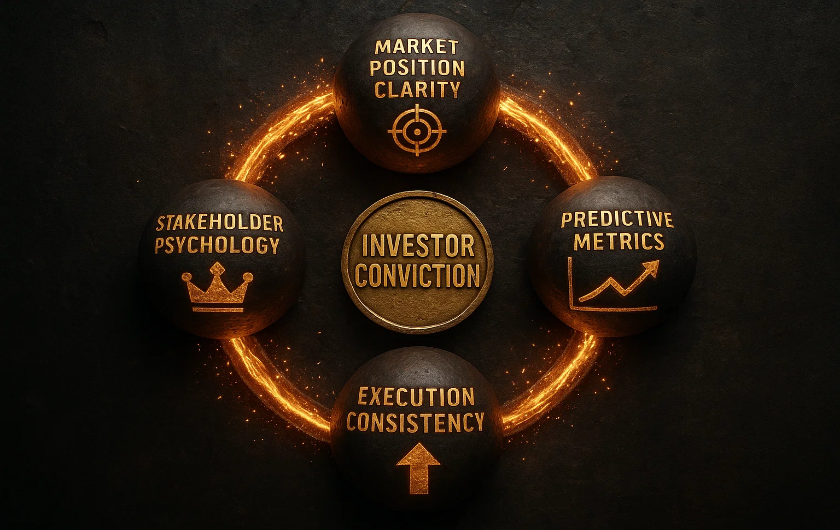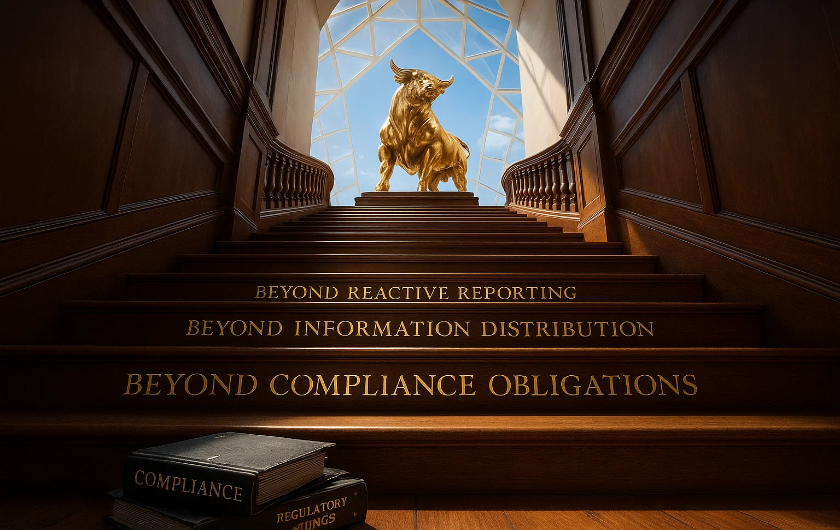The Board Meeting Reality Check: When Performance and Valuation Don't Match
You're in the boardroom. Quarterly numbers exceed guidance. Market share is growing. Customer satisfaction scores are strong. But when your CFO pulls up the stock chart, the room goes quiet.
This scenario plays out in boardrooms across America every quarter. Management teams who have delivered on every operational metric watch their stock trade sideways or decline. Board members start asking uncomfortable questions. Activist investors begin circling. The CEO feels the pressure mounting.
After serving on investment committees for two decades and later leading Finance & IR as an SVP, I've witnessed this disconnect from both perspectives. The frustration is real, but so is the solution. The gap between performance and market recognition isn't always about fundamentals; it can often be it's about how those fundamentals are packaged, positioned, and presented to the investment community.
Most companies approach investor relations as a reporting function. They provide accurate data, meet compliance requirements, and check the communication boxes. But institutional investors aren't just buying your historical performance. They're investing in their confidence about your future trajectory.
This investor relations strategy playbook reveals what separates companies that trade at premium valuations from those that don't. The difference isn't operational excellence; it's narrative engineering that translates performance into investor conviction.
What Institutional Investors Really Want (And Why Most Companies Miss It)
During my years as an institutional investor, I sat through hundreds of management presentations. The companies that earned my investment weren't necessarily the best performers. They were the ones who understood what I needed to make a confident buy decision.
Institutional investors are portfolio managers under pressure. They need simple, defensible investment theses they can explain to their investment committees.
Most management teams focus on explaining what they do rather than why investors should care. They provide operational updates instead of investment narratives. They report metrics instead of meaning. This approach fails because it puts the burden of interpretation on investors who don't have time to decode complex business models.
The companies that consistently attracted institutional capital understood a fundamental truth: investors buy stories they can retell with confidence. Not fictional stories, but clear, compelling narratives about competitive advantage, market opportunity, and predictable execution.
This insight shaped my development of what I call the Valuation Narrative System™. This investor relations strategy framework helps companies communicate in the language institutional investors actually use when making allocation decisions.

The Valuation Narrative System™
Unlike traditional IR that focuses on information dissemination, this systematic approach engineers conviction through four integrated components:
1. Market Position Clarity: Your competitive advantage must be easily understood and defensible. Investors need to grasp not just what makes you different, but what makes that difference sustainable and valuable.
2. Predictive Metrics Selection: Choose 3-5 KPIs that forecast future performance rather than just summarize past results. These metrics should connect directly to your investment thesis and help investors model your business.
3. Execution Consistency: Demonstrate reliability through consistent outperformance of guidance. According to CFA Institute research on investor behavior, predictable execution significantly impacts valuation multiples.
4. Stakeholder Psychology: Understand the specific motivations, constraints, and evaluation criteria of your target investor segment. Different investor types require different communication approaches.
The power of this system lies in its integration. Each component reinforces the others to create a cohesive investor relations strategy that builds rather than dissipates conviction over time.
When institutional investors can easily understand your strategy, model your business, and trust your execution, they reward that clarity with premium valuations. The companies that master this approach consistently trade above their peer multiples.
Implementation Framework: From Confusion to Conviction
Let me share the specific techniques that separate effective investor relations strategy from conventional approaches. These methods come from both evaluating companies as an investor and implementing successful transformations as an operator.
The Confidence-Building Communication Cycle
Building institutional investor confidence requires a systematic approach to every interaction.
During my investment career, I tracked which management teams consistently earned my continued confidence. The pattern was clear: they followed a disciplined communication cycle that reinforced their investment thesis through every interaction.
Preparation Phase: Before any investor interaction, successful management teams stress-tested their narrative against potential objections. This wasn't generic media training — it was rigorous scenario planning based on understanding investor psychology.
Delivery Phase: Instead of presenting operational updates, they connected each data point to their strategic thesis. Revenue growth wasn't just a number; it validated their market opportunity assessment. Margin expansion wasn't just efficiency. It also demonstrated competitive moat strength.
Follow-up Phase: The best management teams treated every investor interaction as market research. They systematically gathered feedback to understand which messages resonated and which created confusion.
Case Study: The Technology Transition Success
I worked with a public technology company navigating a complex platform transition. Their legacy business was mature while their new platform was still gaining traction. Wall Street was skeptical about the transition timeline and ultimate success.
Instead of overselling the new platform's potential, we implemented a disciplined investor relations strategy:
Market Position Clarity: We positioned the transition as strengthening customer relationships rather than chasing market trends. The new platform solved real customer problems that competitors couldn't address.
Predictive Metrics: We introduced leading indicators that predicted platform adoption success. Customer pilot results, renewal rates, and expansion metrics told the story before it showed up in revenue.
Execution Consistency: We set conservative transition milestones and consistently exceeded them. Each quarter's outperformance built credibility for the overall transformation story.
Stakeholder Psychology: We educated investors on how to evaluate platform businesses differently than legacy software models. We provided frameworks they could use to assess our progress.
The result was remarkable. Instead of trading at a discount during the uncertain transition period, the stock gained institutional support. Over 24 months, the company's valuation increased as investors gained confidence in both the transition execution and long-term platform potential.
Beyond Earnings Calls: Strategic Investor Engagement
Most companies treat earnings calls as necessary obligations rather than strategic opportunities. This mindset wastes the highest-visibility platform for building investor conviction.
Effective earnings calls aren't about reporting results; they're about reinforcing investment theses.
The management teams who consistently moved their stocks through earnings calls understood this distinction. They used each call to demonstrate strategic progress, validate market assumptions, and build confidence in future performance.
This required different preparation than most companies employ. Instead of focusing on slide delivery, successful teams prepared for the investor mindset. They anticipated skeptical questions and had credible, confidence-building responses.
The key insight: successful investor communications connect every data point to strategic meaning. Numbers without narrative are just compliance. Narrative without numbers is just hope. The combination builds institutional investor confidence.
Building Internal Alignment: The CEO's Change Management Challenge
Transforming your investor relations strategy from reactive reporting to proactive positioning requires internal cultural change. Having led this transformation from the executive suite, I understand the organizational challenges involved.

The Three-Pillar Internal Business Case
1. Quantify the Valuation Opportunity
Start with concrete numbers. Calculate the financial impact of trading at peer multiples rather than your current discount. For most undervalued companies, this represents tens or hundreds of millions in unrealized shareholder value.
Present this as an addressable market opportunity. Your company may be efficiently run operationally, but it's leaving money on the table from a capital markets perspective. Improving investor sentiment directly impacts enterprise value.
2. Diagnose Current Approach Limitations
Acknowledge your team's hard work while identifying strategic gaps. Point to specific indicators: defensive earnings calls, limited institutional ownership, or analyst coverage that misses key value drivers.
Compare your communication approach to competitors who trade at premium multiples despite similar or weaker fundamentals. The difference often isn't performance; it's positioning.
3. Present the Strategic Solution
Position the Valuation Narrative System™ as an investment in market efficiency. You're not replacing current efforts; you're adding strategic direction that maximizes their impact.
Outline clear success metrics: improved analyst understanding, expanded institutional ownership, higher trading multiples, and more constructive earnings call dialogue.
Overcoming Predictable Resistance
CFO Concerns: "This is an investment in capital efficiency. We're optimizing our cost of capital by improving market perception. The ROI from even modest multiple expansion far exceeds the investment."
IR Team Hesitation: "This enhances rather than replaces current capabilities. We're adding institutional investor psychology expertise that makes everyone more effective. The goal is to elevate the entire function."
Budget Questions: "The cost of strategic investor relations counsel is a fraction of the value created by improved market positioning. We're talking about percentage points of multiple expansion worth millions in enterprise value."
Clear Implementation Signals
Your company needs an upgraded investor relations strategy when:
- Earnings calls consistently generate more questions than confidence
- Institutional ownership lags despite strong fundamentals
- Analyst models miss key business drivers or value creation mechanisms
- Investor feedback reveals confusion about strategy or competitive position
- Stock performance consistently trails peers with similar financial metrics
The companies that recognize these patterns and act proactively maintain pricing power in both good and challenging markets. Those that wait often find themselves fighting uphill battles for credibility when market conditions tighten.
Don't frame this as hiring consultants. Present it as installing systematic processes for translating operational excellence into market recognition. The expertise comes from someone who has allocated institutional capital and understands exactly what drives investment decisions.

Transform Market Perception Through Strategic Positioning
The gap between your company's performance and its market valuation isn't inevitable. It's solvable through an investor relations strategy that goes beyond compliance to engineer the institutional investor conviction that drives premium multiples.
Traditional IR ensures regulatory compliance and provides information. Strategic investor relations strategy transforms that information into compelling narratives that help sophisticated investors understand why your company deserves their capital allocation.
The Valuation Narrative System™ isn't a theoretical framework — it's a proven methodology for translating operational strength into market recognition through systematic positioning, predictable execution, and deep understanding of institutional investor decision-making processes.
Your performance has earned market recognition. Your strategic vision deserves institutional investor backing. Your communication approach should be a competitive advantage, not a compliance obligation.
The institutional capital is available for companies that can articulate clear, credible, compelling cases for sustainable value creation. The question isn't whether your fundamentals justify higher valuations; it's whether your investor relations strategy helps the market reach that conclusion.
Success requires moving beyond reactive reporting to proactive positioning. Beyond information distribution to conviction engineering. Beyond compliance obligations to competitive differentiation.
Ready to close the gap between your company's performance and its market valuation? Schedule a chat with me to discover how the Valuation Narrative System™ can transform your investor relations strategy from cost center to value driver.
Frequently Asked Questions
Q: What defines an effective investor relations strategy?
A: An investor relations strategy systematically builds institutional investor conviction through clear positioning, predictive metrics, consistent execution, and deep understanding of investor psychology rather than just meeting compliance requirements.
Q: How does strategic positioning differ from traditional IR?
A: Traditional IR focuses on accurate information delivery; strategic investor relations strategy engineers conviction by connecting every communication to clear investment theses that institutional investors can confidently support.
Q: What makes the Valuation Narrative System™ different from other IR approaches?
A: This framework was developed by someone who allocated institutional capital for 20 years and then led IR as an operator, providing insights into exactly what drives investor decision-making rather than generic communication best practices.
Q: How quickly can companies see results from improved investor relations strategy?
A: While building institutional credibility takes time, companies often see improved earnings call reception and analyst understanding within 2-3 quarters of implementing systematic strategic positioning approaches.








